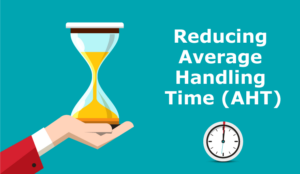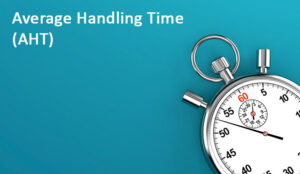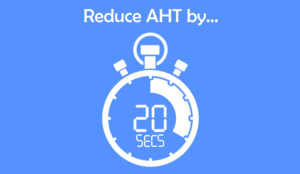Following our last article on reducing AHT, here are 30 more tips that you can use to help decrease call durations and make your contact centre more efficient.
1. Conduct phone-based recruitment interviews
Conduct recruitment interviews using the phone instead of face-to-face. This will highlight the capability of the potential agent.
Thanks to Finlay
2. Encourage data handling within the call
AHT should include the ‘after-call work’ element of a call. One of the biggest wins I’ve found is to eliminate all ACW and encourage all data handling within the call itself.
This we found on average saved 15 seconds per call per agent. It’s tough, it needs training to change culture and habit, but it actually improves the quality of the call as it forces the agent to take ultimate care with the client’s details and agree all actions whilst the customer is on the line.
All that to say – remove ACW!
Thanks to Jason
3. Don’t look at AHT in isolation
We have identified that calls with high customer satisfaction have the lowest average handling times.
AHT can be a blind metric for agents to try and improve, they can’t isolate how to improve their times and they sometimes don’t want to shorten the calls because they care for the customer.
However, providing specific behaviours to improve customer satisfaction can reduce your handling time because the two are linked and agents are happier to be accountable for the satisfaction.
Thanks to Amy
4. Can processes be reduced or automated?
Review processes – is there any duplication of work or can anything be automated? We have reduced AHT by removing all paper forms and automating more processes. Sit with advisors to observe them – are they following the agreed processes? And if not, is this a factor in high AHT?
Thanks to Kirsty
5. It’s all about how to make the customer feel happy
Knowledge is not the most important thing any more for the agent. It’s about how to make the customer happy, and if you can’t help them, the agent can explain why, so the customer understands. The best method to show the agents this is getting them to listen to their own conversation together with a coach and just focus on what they could do extra for the customer.
6. Measure different types of error accuracy
We also measure non-critical error accuracy and critical error accuracy at our contact centre.
7. Get agents to take ownership of root cause
Create ownership by agents: I’ll do my best to solve the problem. I will look with to see what’s the cause of this.
Thanks to Miranda
8. Let agents see what they are doing well
Self-evaluation helps agents understand not only where they are going wrong but also what they are doing well, sharing best practice with colleagues. Praising them also helps.
Thanks to Kathleen
9. Use skills-based routing
Use skills-based routing to route the call, based on specialism, to the most qualified agent.
Thanks to Aldert
10. Anticipate questions
Train your agents to anticipate questions and provide the information before the customer can ask the question.
Thanks to Conrad
11. Avoid ‘over service’
Let agents strictly answer the main question. Teach agents to resolve questions from the customer perspective. Ask the customer what solution they want and do not talk in restrictions.
Thanks to Eddie
12. Use call analysis software
Focus on using intelligent call analysis software to analyse the calls and find out the gaps and poor points of the call. Then organise yourself accordingly, for example, training, system updates if needed, etc.
13. Think of AHT as a positive
Think about your AHT as a positive and not always a negative. Was the AHT right for the call?
By making your staff aware of this and discussing it through coaching and feedback, this will no doubt help reduce your overall AHT.
Thanks to Simon
14. Try to limit referral calls
Have a “What not to refer” guide so agents can make a decision, rather than going through to a referral point.
Thanks to Jane
15. Align your CRM system with an ideal call flow
Mirror your CRM system with perfect call flow so one question leads into another. This gathers all information on the call and can reduce repeat call-backs (to secure further information) and makes a better client experience all round!
Thanks to Lesa
16. Staff must believe that their job is valuable
No matter what systems we have, or average handle times we want to achieve, we must ensure that staff believe that the job they are doing is valuable. It does not matter if they are selling or serving customers, in whatever field – it’s all about people empowerment.
Thanks to Ruth
17. Reward the behaviour
We provide an additional bonus for the maximum number of accepted calls per shift, with the acceptable for us being based on the average time. [Editor’s note – Make sure that you monitor quality on these calls].
Thanks to Alexandra
18. Don’t interrupt the caller
The agent needs to listen. Allow the caller to say what they need to without interruption, then recap and check understanding, addressing one query at a time. This is especially important if the customer is agitated or unhappy with the previous service interaction.
Thanks to Dean
19. Avoid ‘cold transfers’
Avoid ‘cold transfers’ to other departments, or at least send through the client data to avoid repeating the same questions all the time.
Thanks to Julian
20. Ensure objection handling is not disproportionate
Ensure objection on handling sales is not disproportionate. Spending time on tailoring the sales pitch to the customer’s needs, rather than using a blanket approach, would minimise objection handling.
Thanks to Mark
21. A three-step process
Automation, coaching and help for agents -> 3 ways to reduce AHT.
The first is automation (processes, applications…) – make this easier to use for agents, and reduces the average speed of answer.
The next is a Quality programme (listening to calls, giving feedback and coaching agents…).
The third is help for agents (for example, we have floor walkers for this, who are agents with more experience…)
Thanks to Ana
22. Stick to the knowledge base
Agents should try wherever possible to stick to the help files and knowledge base. Also, they should identify the point in the call where it is obviously going to be a long one and then dispatch the incident to a resolver group who will work in the background and call back the user.
Thanks to Mark
23. Review yesterday’s interactions
Listen to calls/look at scripts/check queues/check call types (depending on what is available to you) for the previous day. Identify any trending issues and utilise the message you can record on the IVR to pre-empt these issues and reduce AHT, or even be pro-active with avoidable calls. This will also highlight training needs – a double whammy!
24. Well-written workflows
Produce well-written knowledge workflows to assist the advisor through the call when dealing with various call types. This helps reduce the AHT and also reduces repeat calls and increases first-time resolution.
Thanks to Karen
25. Organise the knowledge base alphabetically
Straight to the point – emails and notes should be organised in alphabetical order, which makes things easy to find.
26. Cut down on the aggressive attitude
Stay positive and smile on the phone, and cut down the aggressive attitude if it is an objection-handling call.
27. Train agents in troubleshooting, not ideal calls
Part of the problem is agents are taught the ideal scenario with procedures to answer to these but once on the phone everything becomes more complicated. They hardly ever face a standard situation; they are more troubleshooters than agents.
Thanks to Johanna
28. Training, training, training
Overcome agents’ lack of product knowledge through comprehensive training. It is never enough, but it works.
Thanks to Elizabeth
29. Route calls to the agent they last spoke to
Use intelligent call routing. This brings up a client’s details on screen if they are calling from a number we hold on the system and passes them directly to the agent they last spoke to. This allows rapport building and also reduces AHT.
30. Work with other departments to reduce call transfer delays
Identify which other departments take a long time to answer and work closely with them, and allow them to keep you informed of their SLAs for answering your calls so you can manage the clients’ and agents’ expectations. You could then arrange call-backs to clients, where appropriate.
Thanks to Sharon
31. Analyse the top 5 types of call
Measure and analyse the types of incoming calls and put the training effort on the top 5-6 call types. Eliminate all the unnecessary steps in these calls and empower agents to finalise the calls.
Thanks to Piret
Click here for our 49 Tips for Reducing Average Handling Time
Do you have any other tips for reducing average handling time? Please leave your comments in an email to Call Centre Helper
Author: Jo Robinson
Reviewed by: Megan Jones
Published On: 3rd Apr 2013 - Last modified: 15th Aug 2025
Read more about - Customer Service Strategy, After Call Work (ACW), Average Handling Time (AHT), Call Handling, Service Strategy, Training and Coaching






































Whenever we look at data from customers there is invariably a direct link between average speed of answer and average handling time.
For intervals where ASA is higher, so is AHT. And vice versa.
So another tip: keep ASA down and AHT will follow.
Identify the top 10 AHT contributor on a given skill set.
# listen to their calls in a same group ask rest of the agents to indentify the irrelevant or repeated information.
# Keep the communication simple, clear, easy to understand. Explain as the caller is “Layman”.
# Make the top 10 AHT contributors to buddy with the quick call resolver.
# It is always recommended to discuss the current call type issues discussed at the start of the day.
# At the start of day discuss recent issues and fixes.
# An media release may trigger call volumes, Or new sales add / Product launch, keep your agents informed and trained on all such issues.
#In technical centers any new update/ patch / virus attack may result in spike in volumes, lightning may result a damage to pc connectivity, do only relevant steps to diagnose.
Avoid dead_air time
It is about team work. So think about your collegues with a higher production rate,yet the same pay.
got this site referral from my line manager.thanks Aliyu its been helpful